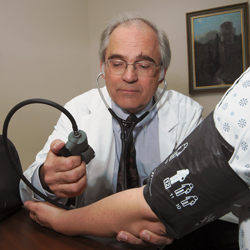Influenza featured at infectious disease meeting
A summary of approvals, recalls, warnings and alerts digested by ACP Internist from the Food and Drug Administration's alerts.
PHILADELPHIA—”I was afraid everyone would be burned out on flu,” said the moderator leading off a well-attended session on seasonal influenza at the annual meeting of the Infectious Diseases Society of America in late October.
Contrary to the moderator's fears, influenza seemed to be a topic that no one could get enough of at the conference, whether they were hearing about new research findings, the latest diagnostic technology or strategies for increasing vaccination.
More shots, less flu
Vaccine expert Paul A. Offit, MD, of the Children's Hospital of Philadelphia, spoke to attendees the first evening about the public debate over the merits of vaccination. During a press conference, he offered some reassurance to anyone worried about the strength of the anti-vaccine movement.
Concerns from parents of immunocompromised kids and the refusal by some doctors to see unvaccinated children, among other factors, are putting the anti-vaccine troops on the defense, he said. “The pendulum is starting to swing the other way.”

There was more good news about vaccination rates from Kathleen M. Neuzil, FACP, of the University of Washington in Seattle. By late October, a record number of seasonal flu vaccines had been given out. “Perhaps this is an outcome of the H1N1 outbreak, but to date, we've had about 90 million doses of seasonal influenza vaccine distributed,” she reported.
The numbers are still too low, she said, considering that the seasonal shot is recommended for at least 300 million Americans. One solution may to be lengthen the vaccination season. “Generally, we start winding down the seasonal flu vaccine program by Thanksgiving, and yet, generally, in a non-H1N1-pandemic year, we see our peak activity in February,” Dr. Neuzil said.
Pregnant women, in particular, should be a target of increased vaccination efforts. “The vast majority of pregnant women do not receive their influenza vaccine,” said Dr. Neuzil.
New research presented at the IDSA meeting provided evidence of the value of maternal flu immunization, particularly for infants. “If they're not doing it for themselves, maybe they'll do it for their babies,” said Marietta Vasquez, MD, a researcher from Yale University.
Her study of 350 Connecticut infants found that vaccination of mothers while pregnant was 84% effective in preventing hospitalization for flu during the babies' first year. Other studies presented at the conference found that maternal vaccination made babies less likely to be premature and underweight, and another trial found that only 10% of infants whose mothers were vaccinated had serological evidence of flu compared with 25% of controls.
An expectant-mother vaccination program should also be especially cost-effective, predicted Dr. Vasquez. “You're talking about one vaccine protecting two people,” she said.
Hitting health care workers
Despite the mounting evidence, even health care workers are not fully convinced of the benefits of flu vaccines, according to another study presented at the meeting.
The one-hospital survey found many misconceptions—such as that flu vaccines aren't safe and could give you the flu—among health care workers, including physicians. The study authors concluded that “universal immunization of health care workers is unlikely without a mandatory policy.”
Thomas R. Talbot, MD, MPH, of Vanderbilt University School of Medicine in Nashville, Tenn., has come to the same conclusion. During another session at IDSA, he reviewed the history and arguments for making flu vaccination a condition of employment for health care workers.
“In general, most voluntary programs have not hit high rates of coverage and really require a great deal of resources,” Dr. Talbot said. He cited Centers for Disease Control and Prevention data finding that about 45% of health care workers were vaccinated yearly in the early part of this decade, with little change in that rate since. “In a five-year period where this issue has been increasingly publicized by various professional societies, rates reached only 49%.”
Influenza could reasonably be added to the list of diseases against which health care workers are already required to be protected, suggested Dr. Talbot. “When we were hired at a hospital, we had to provide documentation of either vaccination or immunity, most likely to MMR, probably to varicella, hepatitis B, and annual TB skin testing. Why is influenza vaccination considered differently?”
Some hospitals around the country have already made the leap to mandatory influenza vaccination. Virginia Mason in Seattle was one of the first to require employees to do more than sign a form to avoid the shot, Dr. Talbot said. “They said, ‘You can't decline. If you say you're egg-allergic, we're going to offer free testing in our allergy clinic. If you say your [objection is] religious, you need to have a letter from your priest [or] your rabbi.’”
A few employees have been dismissed for failure to comply, but for the most part, health systems that mandated vaccination have gotten their rates up to near 100%, Dr. Talbot reported.
Despite these successes, the state of New York recently had to give up an effort to mandate vaccination because of public protest. A major problem was likely the timing of the H1N1 epidemic; “In retrospect, this was a very challenging year to mandate,” said Dr. Talbot.
Communication is also key to successful implementation. “Don't just send a memo,” Dr. Talbot said. Instead, tell workers: “This is why we're doing it. It's for safety. It's a patient safety issue. Let's have a dialogue.”
The conversation, rather than the evidence, may be the deciding factor in whether employees go along with vaccination. “The care setting where we may have the most data to show an impact on patients is in the nursing home, yet we still have the lowest rates there,” said Dr. Talbot.
A fever of research
Nursing home worker vaccination is particularly important because elderly patients often have a less robust response to the flu shot, but researchers are hard at work on that problem, according to Dr. Neuzil.
She has conducted studies to determine any factors that could indicate which patients will not respond to vaccination but has found no useful markers. “What was predictive was a serology measure that obviously isn't practical in the real world.”
There has been progress in development of more effective vaccines, however. Sanofi has developed a higher-dose vaccine (60 micrograms of each virus strain instead of 15). The trial patients, who were over 65, showed better response to the high dose than the normal dose, although there were more local reactions, Dr. Neuzil said. The vaccine was approved under the FDA's accelerated pathway in December 2009.
Other companies are working on adjuvanted vaccines to increase effectiveness. More than 40,000 elderly patients are involved in a multi-year trial of an oil and water adjuvant that should produce results within the next year, according to Dr. Neuzil. “I think the landscape of influenza vaccine development is rapidly evolving,” she concluded.
Tests for influenza are also changing at a speedy pace, according to Dan Jernigan, MD, of the CDC. Public health authorities are eager to find diagnostic methods for flu that are fast and simple enough for clinical use as well as provide the detailed information needed to match vaccines and detect emerging viruses.
Rapid immunoassay tests don't appear to have achieved that goal so far, according to Dr. Jernigan. In fact, during the H1N1 outbreak, false negatives may have provided a sense of security that facilitated disease spread. “In Georgia, we know the negative results were sending kids back to camps,” Dr. Jernigan said.
New flu tests did have value in the outbreak, however. The first H1N1 patient identified in the U.S. was a participant in a trial of an investigational influenza test. When his sample was found “unsubtypable” by the test, it was passed along to health authorities and eventually determined to be a new strain.
The epidemic has also provided an opening for some newly developed tests to move into the field. Several hospital-based flu diagnostics that were still in the investigational phase received emergency use authority from the FDA after H1N1 was declared a public health emergency. “They're kind of Cinderella agents. After the emergency stops, they go back to being what they were before,” said Dr. Jernigan.
Similarly, next year's infectious disease news may go back to being about something other than influenza.





